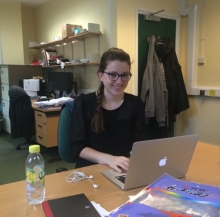
University:
Major:
Site Abroad:
Mentor(s):
Faculty Sponsor(s):
Faculty Sponsor's Department:
Project Title:
Project Description:
Diamond color centers are leading contenders for solid state qubits in quantum processors, nanoscale quantum sensors, and single photon sources. A current bottleneck in developing these technologies is the creation of an efficient optical interface in which light emitted by the color center is passed into an optical system in a controlled way. One such technology uses open optical microcavitites to enhance and direct the emission of the system. These microcavities are formed by placing two distributed Bragg reflectors, one planar and one hemispherical, adjacent to one another. Finite Difference Time Domain, a computational method for solving Maxwell’s equations, was used in this project to simulate the optical coupling between the cavity modes and nitrogen vacancy (NV) centers in nanodiamond. The geometry of the microcavity was first tuned to place the fundamental cavity mode at 690nm, the center of the room temperature emission spectrum of the color center. By finding the optimal radius of curvature for the hemispherical mirror, further simulations optimized the design of the cavity to most efficiently enhance photon emission. In order to couple efficiently to the cavity mode the NV center should be as close as possible to the electric field intensity maximum, but as the diamond has a high refractive index finding this position is not trivial. The field distribution, and particularly its behavior in and around the nanodiamond, was studied as a function of the size and location of the diamond within the cavity.
